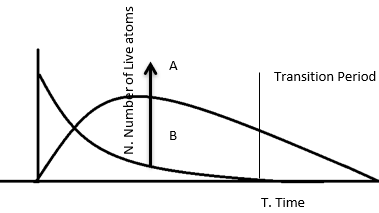Consider a radioactive nucleus A which decays to a stable nucleus C through the following sequence:
A → B → C
Here B is an intermediate nucleus which is also radioactive. Considering that there are ![]() atoms of A initially, plot the graph showing the variation of number of atoms of A and B versus time.
atoms of A initially, plot the graph showing the variation of number of atoms of A and B versus time.
A radioactive equilibrium is established when the rate of decay and production of radioactive nuclides is same. The nucleus in this case is A that is decaying and the production nuclei is B. The daughter nuclide can further become parent to the daughter nuclide of C, but in this question we have to find the relationship between nucleus A and B. The strength of the daughter nuclei depends on the half-life and decay constant. As mentioned earlier, the rate of production and decay are same, therefore the number of atom present with respect to time will become same for both the parent and daughter but before equilibrium both the parent and the daughter will go through, what we call a transition period. That means in our case the number of parent nuclei A decreases overtime as time goes on and due to radioactive decay law the rate of production of the number of live atoms for B increases to a maximum point and then again decays with time to achieve equilibrium with A. therefore, the graph depicting the production and decay of both B and A is

In the above graph at t = 0;
![]()
The number atoms for A decreases exponentially overtime while for B it first increases till the transition period and after that when it starts decaying it achieves equilibrium with A.